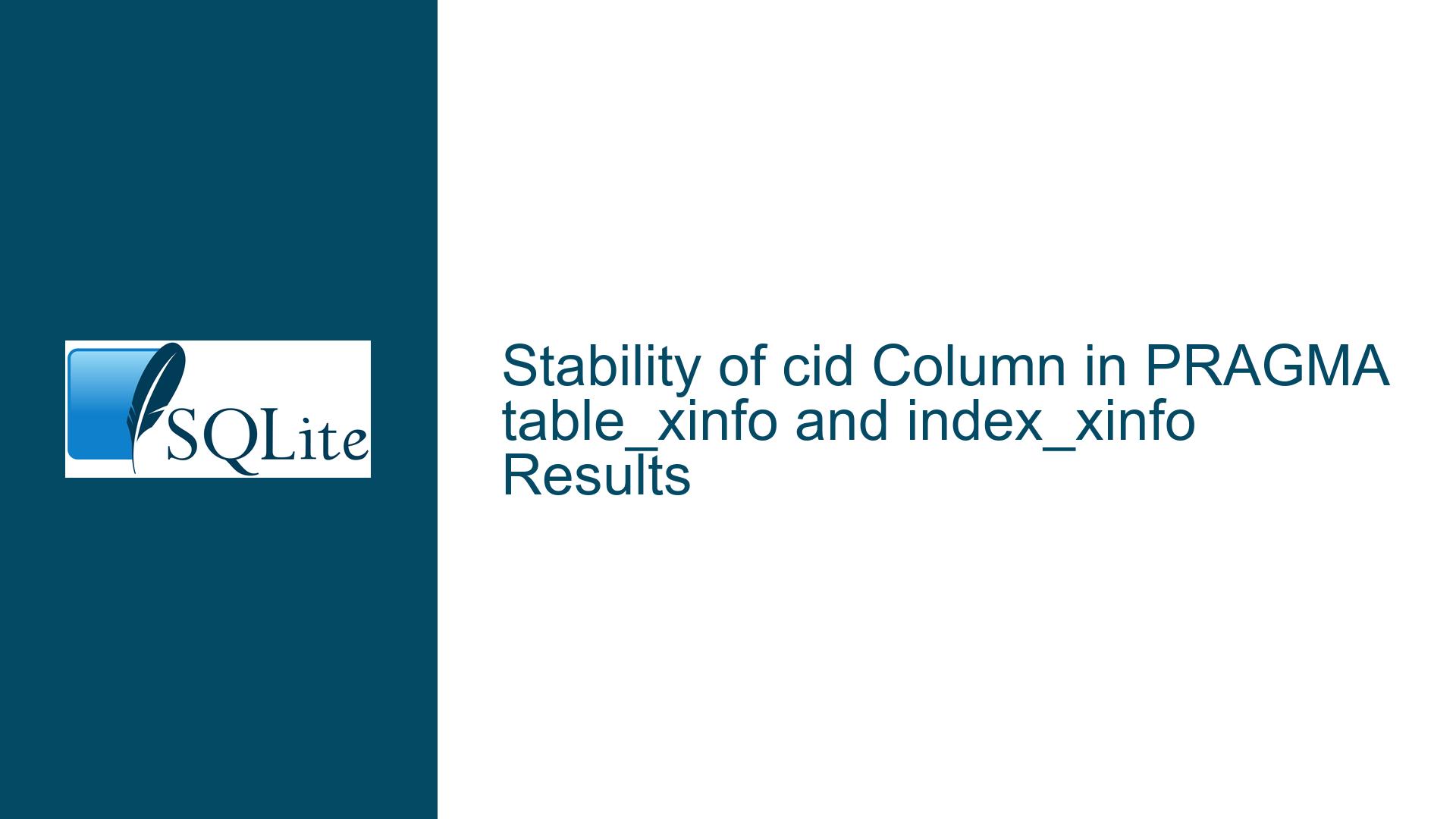Stability of cid Column in PRAGMA table_xinfo and index_xinfo Results
Understanding the Role of cid in PRAGMA table_xinfo and index_xinfo
The cid column returned by SQLite’s PRAGMA table_xinfo and PRAGMA index_xinfo has been a subject of debate regarding its stability and reliability for correlating columns between tables and indexes. The core issue revolves around whether the cid values from these pragmas can be reliably used to match columns across different contexts, such as between a table and its associated indexes. Users have observed that while cid often appears to correspond to the ordinal position of a column in its table or index, this behavior is not explicitly documented or guaranteed by SQLite. This raises concerns about whether applications or tools relying on cid for schema introspection might break due to changes in SQLite’s internal implementation or schema modifications.
The PRAGMA table_xinfo command provides metadata about all columns in a table, including hidden and generated columns. Its output includes a cid column that historically reflects the order in which columns were declared in the table. Similarly, PRAGMA index_xinfo returns information about the columns (or expressions) in an index, including a cid column that, for indexed table columns, appears to match the cid from table_xinfo. However, SQLite’s documentation does not formally define the semantics of cid, leaving room for ambiguity. For example:
- Is
cidstable across schema changes (e.g.,ALTER TABLEoperations)? - Does
cidhave the same meaning intable_xinfoandindex_xinfo? - Are
cidvalues guaranteed to align with the physical storage order of columns?
These questions are critical for developers building tools that introspect SQLite schemas programmatically. A mismatch in cid values could lead to incorrect assumptions about column relationships, especially when dealing with generated columns, hidden columns (e.g., rowid aliases), or virtual tables.
Undocumented Behavior and Schema Evolution Risks
The instability of cid stems from two primary factors: undocumented behavior and schema evolution risks.
Undocumented Behavior:
SQLite’s documentation forPRAGMA table_xinfoandPRAGMA index_xinfohistorically omitted details about thecidcolumn, including its purpose and guarantees. While thecidwas observed to represent the column’s ordinal position in the table or index, this was an implementation detail rather than a contractual guarantee. SQLite reserves the right to change such details in future releases, which could invalidate tools or workflows relying oncidstability. For instance, a future version of SQLite might renumbercidvalues after schema alterations or introduce new column types that disrupt the existing numbering.Schema Evolution Risks:
Even ifcidwere stable within a single SQLite version, schema changes can invalidate assumptions aboutcidalignment. Consider a tabletblwith columnsa,b, andc. Thecidvalues for these columns might be 0, 1, and 2, respectively. If a generated columndis added,PRAGMA table_xinfomight assign itcid=3. However, if the table is recreated with a different column order (e.g., usingALTER TABLE ... RENAME TOworkarounds), thecidvalues could shift unexpectedly. Similarly, hidden columns (e.g.,rowidaliases) may occupycidpositions that are not contiguous with visible columns.Index-Specific Ambiguities:
Indexes in SQLite can include expressions or columns from multiple tables (in the case of partial indexes or indexes on virtual tables). Thecidvalues inPRAGMA index_xinfomay not map cleanly to table columns, especially when indexes involve computed values. For example, an index ona+1would not correspond to anycidin the base table, yetindex_xinfomight still report acid(e.g.,-1for rowid-based references).
Reliable Alternatives to cid-Based Column Matching
To avoid reliance on cid, developers should adopt strategies that use column names for correlating metadata between tables and indexes. Below is a structured approach to achieve robust schema introspection:
Step 1: Use Column Names for Cross-Referencing
Column names are stable, user-defined identifiers that are explicitly documented and guaranteed to be unique within their context (table or index). Instead of joining PRAGMA table_xinfo and PRAGMA index_xinfo results on cid, join them on the name column. For example:
-- Get indexed columns and their corresponding table columns
SELECT
idx.name AS index_name,
idx_col.name AS index_column,
tbl_col.name AS table_column
FROM
(SELECT * FROM pragma_index_list('my_table')) idx
JOIN
(SELECT * FROM pragma_index_xinfo(idx.name)) idx_col
ON idx_col.name = tbl_col.name
JOIN
(SELECT * FROM pragma_table_xinfo('my_table')) tbl_col
ON tbl_col.name = idx_col.name;
Step 2: Handle Generated and Hidden Columns Explicitly
Generated columns (virtual or stored) and hidden columns (e.g., rowid) may not appear in all pragma outputs. Use the hidden column in PRAGMA table_xinfo to filter or annotate these cases:
SELECT
name,
type,
hidden,
CASE hidden
WHEN 1 THEN 'Virtual Generated'
WHEN 2 THEN 'Stored Generated'
WHEN 3 THEN 'rowid Alias'
ELSE 'Ordinary Column'
END AS column_type
FROM pragma_table_xinfo('my_table');
Step 3: Validate Against SQLite’s Documentation Updates
Recent updates to SQLite’s documentation explicitly warn against relying on cid stability. Consult the latest documentation for PRAGMA table_xinfo and PRAGMA index_xinfo to verify guarantees about column names and behavior. For example:
- The
namecolumn is guaranteed to reflect the user-defined column name. - The
hiddencolumn categorizes generated/hidden columns with documented values (0 for ordinary, 1–3 for specific hidden types).
Step 4: Test for cid Stability in Target Environments
If migrating an existing codebase away from cid is impractical, conduct thorough testing to identify cid-dependent assumptions. Use schema alteration scripts to simulate column reordering and validate whether cid values remain consistent:
-- Simulate column reordering by recreating a table
BEGIN TRANSACTION;
ALTER TABLE my_table RENAME TO my_table_old;
CREATE TABLE my_table (c, b, a); -- Columns reversed
INSERT INTO my_table SELECT c, b, a FROM my_table_old;
DROP TABLE my_table_old;
COMMIT;
-- Check cid values after reordering
SELECT * FROM pragma_table_xinfo('my_table');
Step 5: Leverage SQLite’s Internal Schema Tables
For advanced use cases, query SQLite’s internal sqlite_master table and sqlite_schema pragmas to derive column order from the original CREATE TABLE/CREATE INDEX statements. This approach is brittle but can provide insights into the schema’s evolution:
-- Extract column order from the table definition
SELECT
sql
FROM
sqlite_master
WHERE
type = 'table'
AND name = 'my_table';
Step 6: Monitor for Future SQLite Changes
Subscribe to SQLite’s release notes and changelogs for updates affecting pragma behavior. For instance, if a future version formalizes cid semantics, adjust your codebase accordingly. Until then, treat cid as an undocumented implementation detail.
By prioritizing column names and adhering to documented guarantees, developers can future-proof their applications against SQLite internals changes. The cid column, while convenient for ad-hoc inspections, lacks the contractual stability required for programmatic use.






